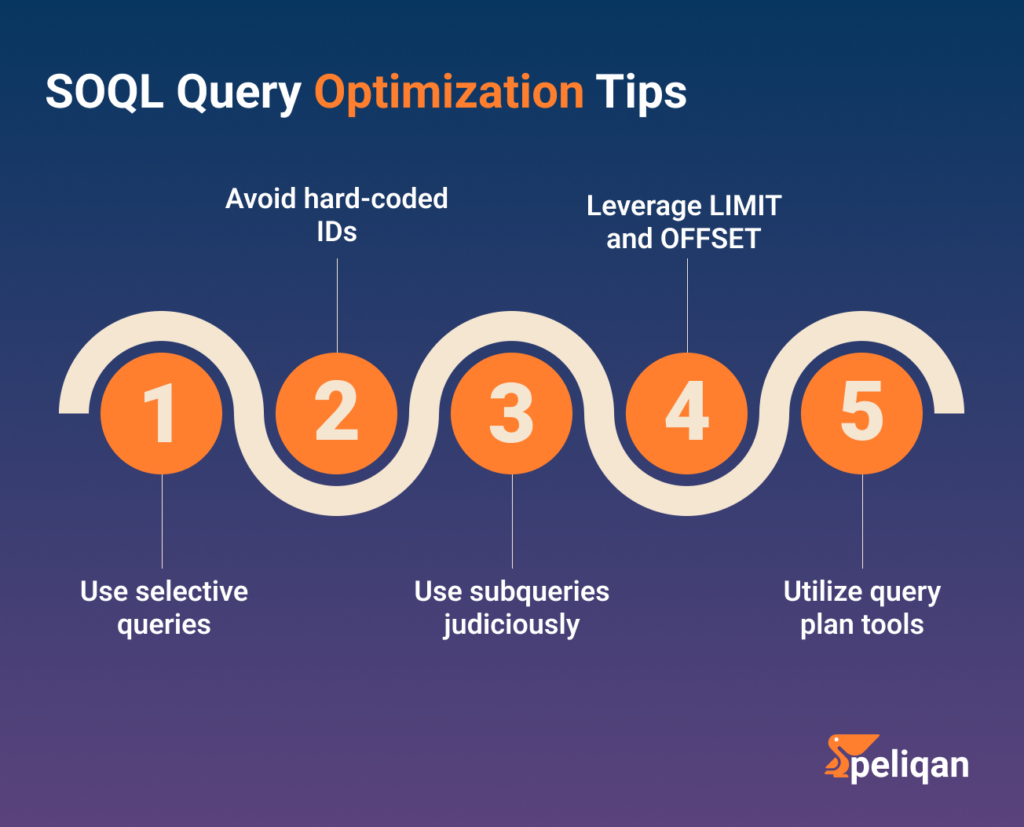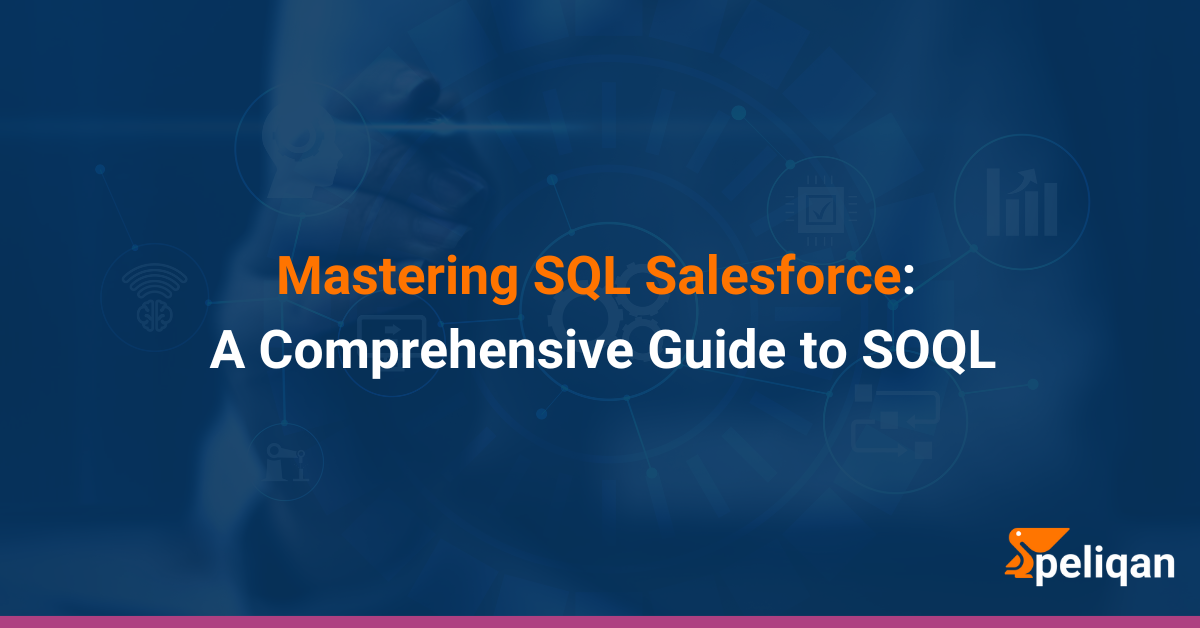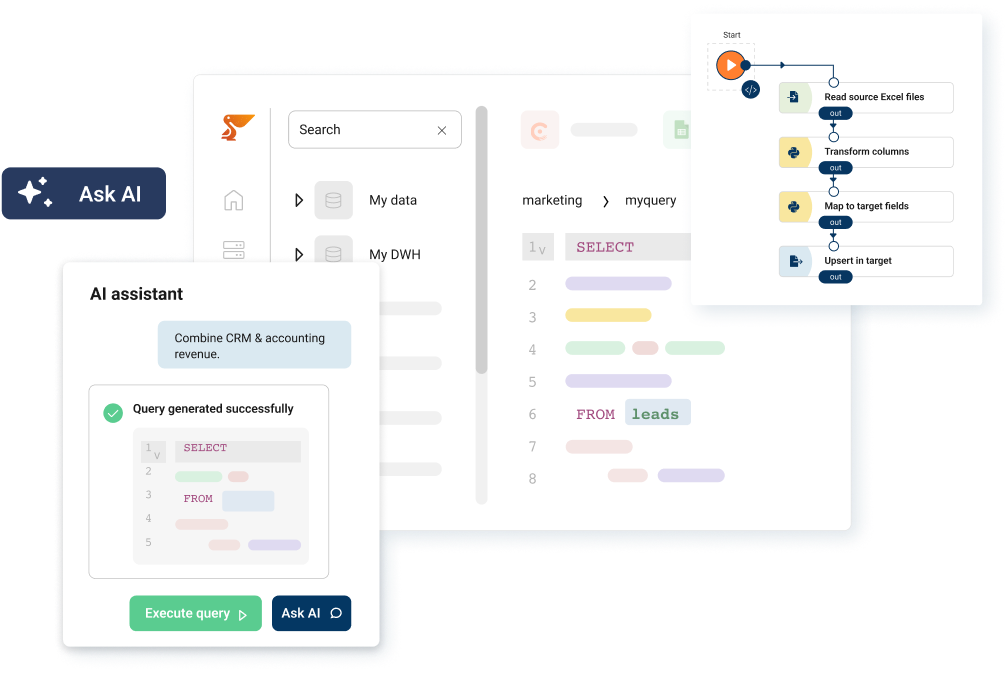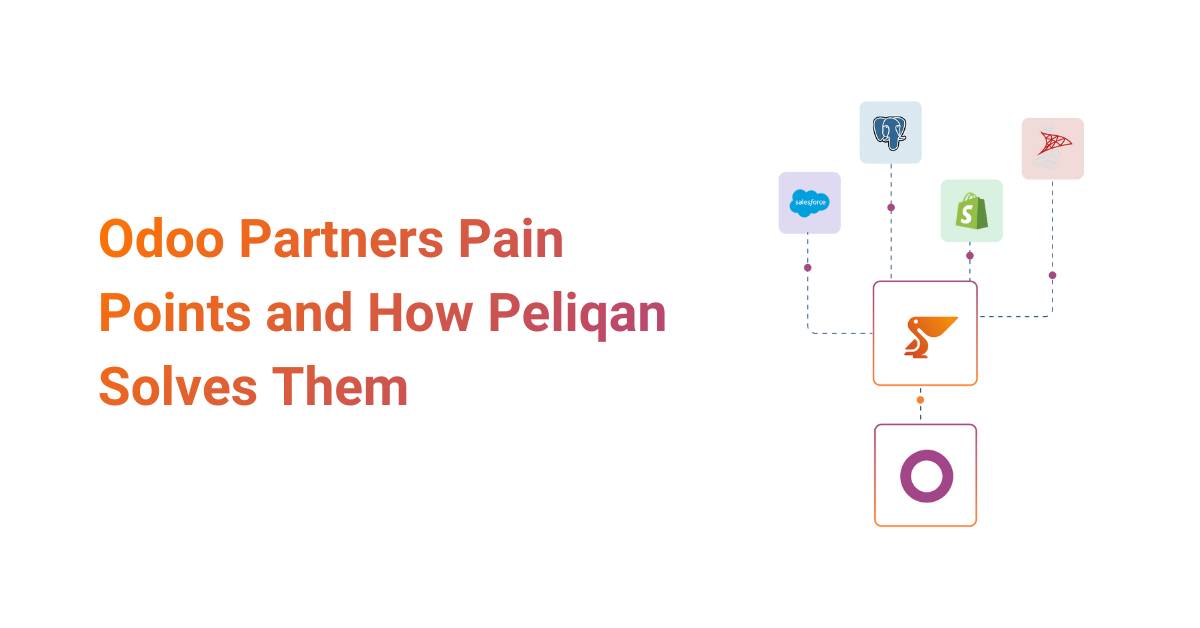In today’s data-driven business landscape, the ability to effectively extract, analyze, and leverage Customer Relationship Management (CRM) data is paramount.
For a significant number of enterprises worldwide, Salesforce serves as the cornerstone of CRM operations. However, the true value lies in the capacity to harness this wealth of information efficiently. This is where SQL Salesforce, specifically through Salesforce Object Query Language (SOQL), emerges as the key to unlocking the full potential of your CRM data.
Understanding SQL Salesforce: The Basics of SOQL
While traditional SQL is widely recognized as the standard language for relational databases, Salesforce employs its own specialized dialect: Salesforce Object Query Language (SOQL). This proprietary language is meticulously designed to complement Salesforce’s unique object-oriented architecture, offering a strategic blend of familiarity and innovation that distinguishes it from standard SQL implementations.
SQL Salesforce, through SOQL, allows you to query and manipulate data stored in Salesforce objects. An object in Salesforce is similar to a table in a relational database, representing a specific entity like accounts, contacts, or opportunities. SOQL queries are used to retrieve data from these objects based on specified criteria.
SOQL vs. SQL: Key Differences
To fully appreciate the capabilities of SQL Salesforce, it’s essential to understand its core differences from traditional SQL:
| Feature | SOQL (SQL Salesforce) | Traditional SQL |
|---|---|---|
| Database Structure | Designed for Salesforce’s object-oriented architecture, mirroring the platform’s data model. | Built for traditional relational table-based structures found in most databases. |
| Query Focus | Adopts a field-centric approach, aligning with Salesforce’s object-field hierarchy. | Utilizes a table-centric approach, focusing on entire tables and their relationships. |
| Join Operations | Leverages implicit relationship queries, simplifying complex data retrieval across related objects. | Requires explicit JOIN clauses to connect data from multiple tables. |
| Data Manipulation | Primarily supports read-only operations through SELECT statements, maintaining data integrity. | Offers full CRUD (Create, Read, Update, Delete) capabilities, providing more flexibility but requiring careful management. |
| Security Integration | Seamlessly integrates with Salesforce’s robust security model, ensuring data access aligns with user permissions. | Typically requires custom security configurations to protect sensitive data. |
Understanding these differences is crucial for effectively leveraging SQL Salesforce in your CRM operations. By recognizing SOQL’s unique features, you can craft more efficient queries and extract more valuable insights from your Salesforce data.
SOQL Queries in salesforce: A Comprehensive Toolkit
Unlike the simple Salesforce report builder, SOQL serves as a versatile and powerful instrument for Salesforce data manipulation, designed to address a wide spectrum of data challenges. Let’s explore the key components of the SOQL toolkit:
Relationship Queries: Enhanced Data Navigation
SOQL’s relationship queries facilitate seamless navigation between related objects, such as contacts and accounts, or opportunities and products. This capability enables a holistic view of the data landscape, crucial for comprehensive analysis. For example, you can easily retrieve all contacts associated with a specific account, along with their related opportunities, in a single query.
Aggregate Queries in Salesforce: Advanced Data Analysis
SOQL incorporates a range of aggregate functions, enabling sophisticated data analysis. These functions allow for operations such as calculating total sales, determining average deal sizes, and other critical metrics that transform raw data into actionable insights. By using functions like COUNT(), SUM(), and AVG(), you can quickly generate summary reports without the need for complex data exports and manual calculations.
Date Literals: Temporal Data Analysis
The inclusion of date literals in SOQL simplifies time-based analysis. This feature allows for efficient querying of historical data or future projections without the need for complex date calculations. You can easily retrieve records from the last quarter, the current fiscal year, or even future dated records, streamlining time-sensitive reporting and forecasting.
Semi-Joins and Anti-Joins: Refined Data Filtering
These advanced querying techniques enable data filtering based on the presence or absence of related records, facilitating more nuanced and targeted data analysis. For instance, you can use semi-joins to find all accounts that have associated opportunities, or anti-joins to identify leads without any related activities, helping to prioritize follow-ups and resource allocation.
By mastering these SOQL components, you’ll be equipped to extract more meaningful insights from your Salesforce data, enabling data-driven decision-making across your organization.
SOQL Query Optimization Tips
To ensure optimal performance of your SOQL queries:

- Use selective queries to improve performance by filtering on indexed fields. Salesforce automatically indexes certain fields, such as Id, Name, and OwnerId. Filtering on these fields can significantly speed up query execution.
- Avoid hard-coded IDs; use dynamic references instead to make your queries more flexible. This approach makes your code more maintainable and adaptable to different Salesforce environments.
- Use subqueries judiciously, as they can impact query performance if overused. While subqueries are powerful for retrieving related data, excessive use can lead to slower query execution and potential timeout issues.
- Leverage LIMIT and OFFSET clauses for pagination when dealing with large datasets. This approach helps manage memory usage and improves query response times.
- Utilize query plan tools provided by Salesforce to analyze and optimize your queries. The Query Plan tool in the Developer Console can help you identify potential performance bottlenecks in your SOQL queries.
By implementing these advanced techniques and following best practices, you’ll be able to craft more efficient and powerful SQL Salesforce queries, unlocking deeper insights from your CRM data.
Strategic Approach to SQL Salesforce Mastery
To achieve proficiency in SQL Salesforce, follow this structured approach:
Master fundamental SOQL syntax and query structure:
Start with basic SELECT statements and gradually incorporate more complex clauses like WHERE, ORDER BY, and GROUP BY. Practice writing queries that filter, sort, and aggregate data to answer specific business questions. Understand the nuances of SOQL syntax compared to standard SQL to avoid common pitfalls.
Learn to navigate object relationships effectively:
Explore Salesforce’s standard and custom object relationships. Practice writing queries that span multiple related objects to retrieve comprehensive datasets. Understand the implications of different relationship types (lookup, master-detail) on query performance and data accessibility.
Leverage aggregate functions for data summarization and analysis:
Familiarize yourself with functions like COUNT(), SUM(), AVG(), MIN(), and MAX(). Practice using these functions in combination with GROUP BY clauses to generate meaningful business insights. Understand how to use HAVING clauses to filter aggregated results for more precise analysis.
Optimize query performance through selective querying and best practices:
Learn to use indexed fields and understand query selectivity to improve performance. Practice writing efficient queries that minimize processing time and resource usage. Utilize Salesforce’s query plan tools to analyze and optimize complex queries, ensuring they scale well with large datasets.
Integrate SOQL with Apex for advanced automation and applications:
Explore how to embed SOQL queries within Apex triggers, classes, and batch jobs. Practice creating dynamic SOQL queries that adapt to runtime conditions. Understand best practices for error handling and bulkification when working with SOQL in Apex to ensure your code is robust and scalable.
Stay updated on evolving Salesforce features and capabilities:
Regularly consult Salesforce release notes and documentation to learn about new SOQL features and optimizations. Participate in the Salesforce developer community through forums, webinars, and events to exchange knowledge and stay abreast of emerging best practices. Continuously experiment with new Salesforce features and their implications for data querying and analysis.
Streamlining SQL Salesforce with Peliqan
While the Salesforce Developer Console provides a robust environment for SOQL queries, modern tools like Peliqan can significantly streamline your Salesforce data management workflow. Peliqan is an all-in-one data platform that offers seamless integration with Salesforce and other data sources, making it easier than ever to work with your CRM data.
Key Features of Peliqan for SQL Salesforce:
- One-Click ETL: Easily connect to Salesforce and other data sources with Peliqan’s one-click ETL functionality. This allows you to bring all your Salesforce data into a centralized data warehouse without writing complex integration code.
- SQL and Low-Code Python Transformations: Peliqan allows you to transform your Salesforce data using both SQL and low-code Python. This flexibility enables you to perform complex data manipulations that might be challenging with SOQL alone.
- Built-in Data Warehouse: With Peliqan’s built-in data warehouse, you can store and analyze your Salesforce data alongside data from other sources, providing a holistic view of your business operations.
- AI-Assisted Query Writing: Peliqan’s AI assistant can help you write SQL queries, including those for Salesforce data, by allowing you to ask questions in plain English. This feature can significantly speed up your data analysis process.
- Data Lineage and Catalog: Automatically track the lineage of your Salesforce data as it moves through your analytics pipeline, ensuring data governance and transparency.
- Reverse ETL and Data Sync: Keep your Salesforce data in sync with other business applications, enabling seamless data flow across your organization.
Example: Using Peliqan to Enhance Salesforce Analytics
Let’s say you want to combine Salesforce opportunity data with marketing campaign data from another platform to get a comprehensive view of your sales and marketing performance.
- Connect Salesforce and your marketing platform to Peliqan using pre-built connectors.
- Use SQL in Peliqan to join and transform the data:
SELECT sf.OpportunityName, sf.Amount, sf.CloseDate, mp.CampaignName, mp.CampaignCost FROM salesforce_opportunities sf JOIN marketing_campaigns mp ON sf.CampaignId = mp.CampaignId WHERE sf.CloseDate >= DATE_SUB(CURRENT_DATE(), INTERVAL 90 DAY)
- Use Peliqan’s low-code Python to calculate ROI:
def calculate_roi(row): return (row['Amount'] - row['CampaignCost']) / row['CampaignCost'] * 100 df['ROI'] = df.apply(calculate_roi, axis=1)
- Visualize the results using Peliqan’s built-in tools or connect to your favorite BI platform.
By leveraging Peliqan alongside your Salesforce instance, you can unlock deeper insights and streamline your data management processes, taking your SQL Salesforce capabilities to the next level.
Conclusion: The Future of SQL Salesforce and Data-Driven CRM
Mastering SQL Salesforce through SOQL is essential for organizations looking to maximize the value of their Salesforce data. By understanding the fundamentals of SOQL, leveraging advanced techniques, and applying these skills to real-world scenarios, businesses can unlock deeper insights and drive more informed decision-making.
As Salesforce continues to evolve, we can expect further enhancements to SOQL and the introduction of new tools to simplify data management and analysis. Platforms like Peliqan are at the forefront of this evolution, offering innovative solutions that bridge the gap between Salesforce and other data sources, and providing powerful tools for data transformation and analysis.
Remember, the key to success with SQL Salesforce lies not just in technical proficiency, but in the ability to translate data insights into actionable strategies that drive business growth. By combining SOQL expertise with modern data platforms like Peliqan, you’ll be well-positioned to lead your organization into a future where data truly is the new currency.
Ready to take your Salesforce data management to the next level? Explore Peliqan’s advanced data integration and analysis tools to supercharge your SQL Salesforce capabilities and unlock the full potential of your CRM data. With Peliqan, you can connect, transform, and activate your Salesforce data like never before, driving innovation and growth across your organization.





